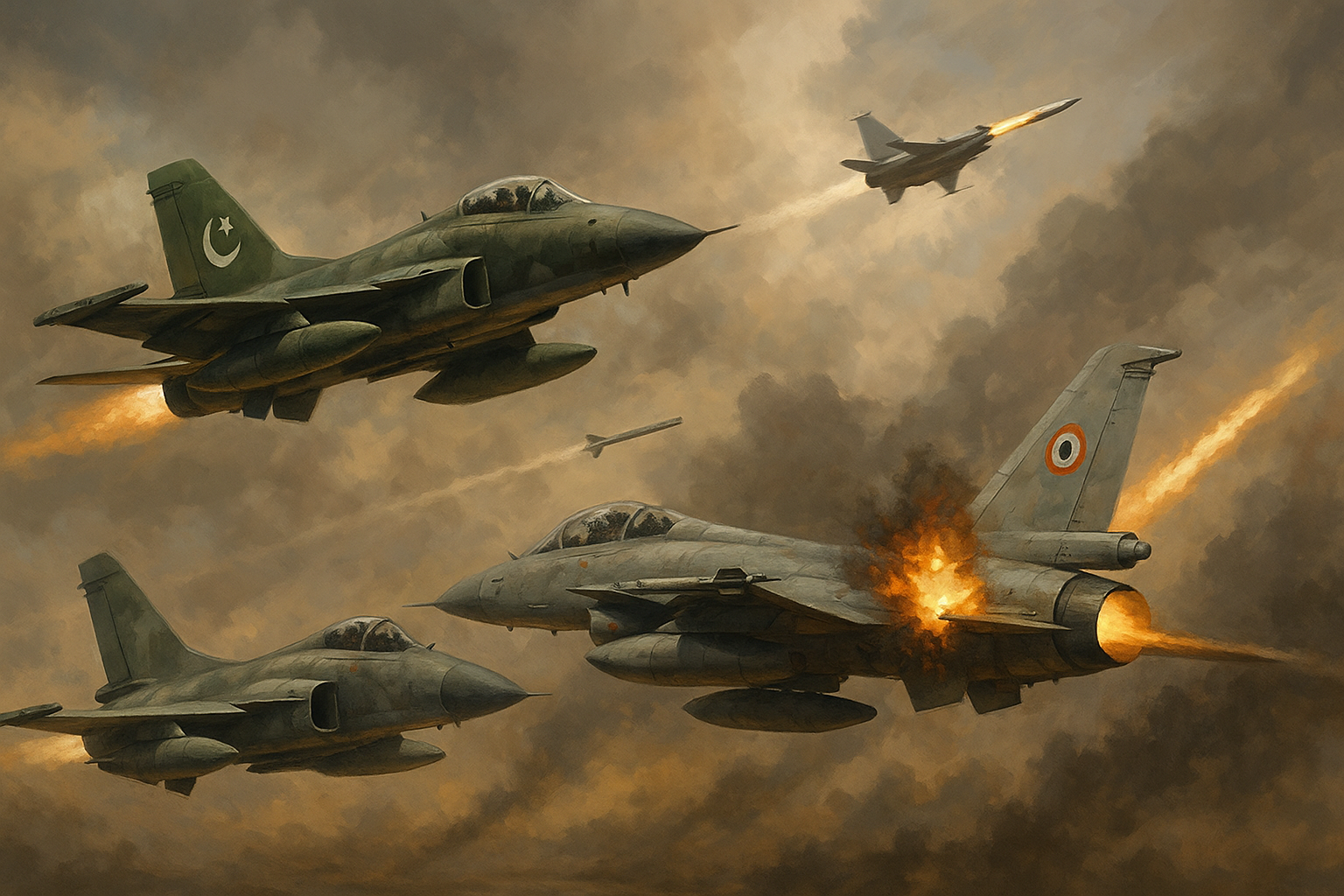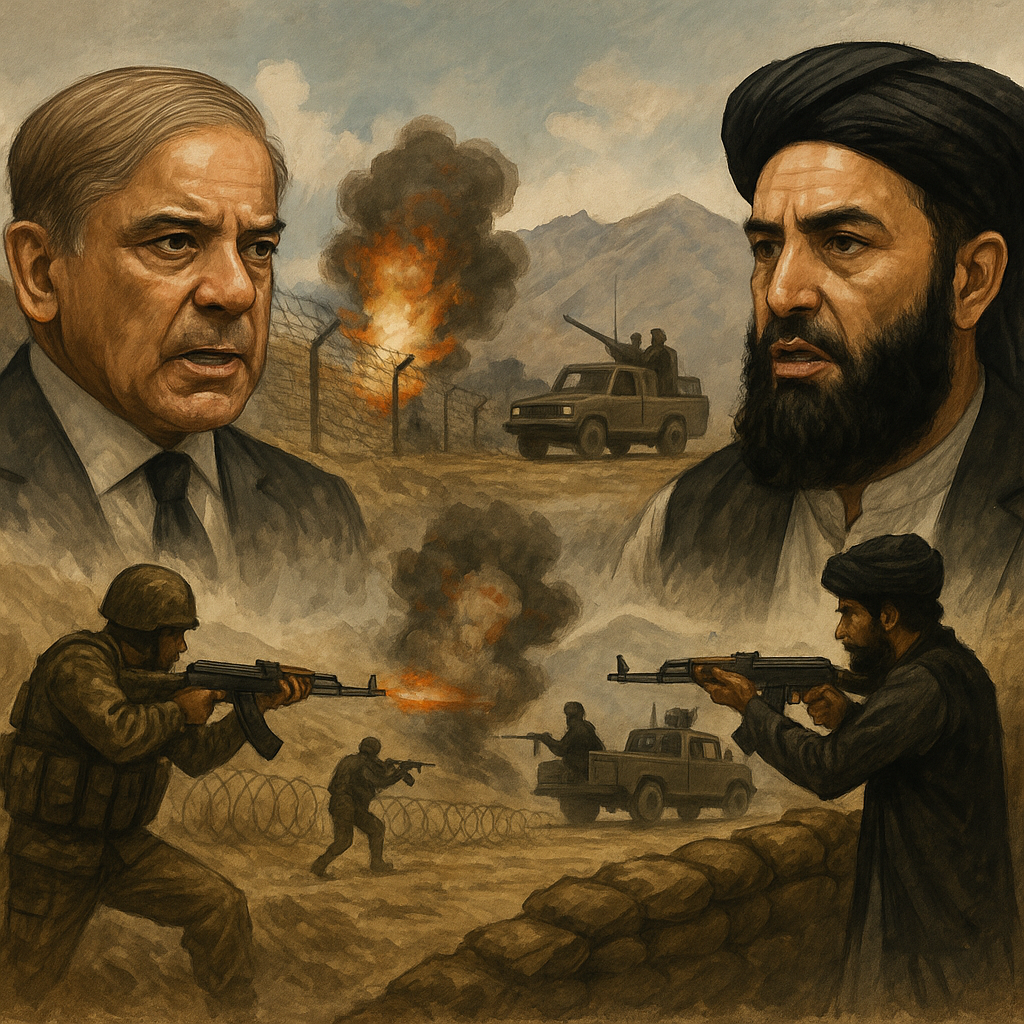
Saima Khan
When the warplanes took off in May 2025, so did the headlines—some flew straight, some crash-landed in fantasy, and a few never left the hangar of propaganda. So, let’s taxi down the media runway—from the chest-thumping Indian studios to the tight-lipped Chinese dispatches, through the West’s slow-burning realization and Pakistan’s calm clarity—to figure out who really won the narrative dogfight. And what was the Final Verdict.
The dust has settled, the ceasefire holds, and the digital battlefields are quiet. But the echoes of May 2025’s India-Pakistan conflict still reverberate, not just in the strategic corridors of South Asia, but in the annals of media absurdity. What began with an attack in a heavily militarized valley quickly devolved into a war in contrasting narratives, where facts fought a losing battle against fabricated F-16s and studio-floor dogfights.
Background & Trigger Event – The Pahalgam Attack (April 22, 2025)
The stage was set on April 22, 2025, when a militant strike in Pahalgam, Indian-administered Kashmir, brutally claimed the lives of approximately 26 innocent civilians, including a Nepali national. This heavily militarized region, a perennial flashpoint, immediately became the epicenter of India’s reflexive blame-game. Without so much as a pause for evidence, Indian media and politicians launched into a familiar chorus: “Pakistan did it!” (NDTV, India). The Resistance Front (TRF), an offshoot of Lashkar-e-Taiba (LeT), claimed responsibility, a group India swiftly linked to Pakistan, it said. New Delhi’s response was swift and punitive, announcing “Operation Sindoor” on May 7, targeting what it termed “terrorist infrastructure” in Pakistan. This was followed by threats to suspend the Indus Waters Treaty and impose trade restrictions.
Across the border, Pakistan’s response was a stark contrast. Islamabad vehemently rejected India’s allegations, calling for an evidence-based inquiry and de-escalation (Dawn, Pakistan). Meanwhile, Chinese outlets, ever the pragmatists, flagged the region as a powder keg (Global Times, China), while the Western press, initially, showed a cautious restraint (BBC, UK; New York Times, USA).
Pre-War Media Narratives (“Drums and Delusions”)
As the tension mounted, the media machines whirred into action, each crafting a narrative designed for domestic consumption and international influence.
Indian Media: The Indian media, particularly its boisterous TV channels, launched a preemptive psychological operation. The airwaves were thick with “surgical strike 2.0” hype, a recycled fantasy from previous skirmishes. Headlines screamed about “terror” and “Pakistan did it” claims, pushing a jingoistic fervor that left little room for nuance or, dare we say, facts (Hindustan Times, India). This was less journalism, more a nationalistic pep rally.
Pakistani Media: In stark contrast, Pakistani media played it remarkably calm. Outlets like Geo News and ARY News highlighted the glaring lack of evidence from India, consistently cautioning against escalation and emphasizing the need for dialogue and diplomacy (Geo News, Pakistan; ARY News, Pakistan).Their message was clear: restraint, not rhetoric.
Western Media: Initial Western coverage, while acknowledging the gravity of the situation, often adopted a cautious tone. Experts from the Atlantic Council noted the “jingoism” emanating from Indian outlets, urging a more balanced perspective (Atlantic Council, USA). Editorials in publications like The Guardian (UK) and Foreign Policy (USA) published cautious warnings of an “escalatory spiral,” a polite way of saying, “Please, for the love of God, don’t do anything stupid”.
Chinese Media: The Chinese press, ever the strategic observers, maintained a cool, analytical distance. Xinhua (China) and other outlets emphasized strategic concern, warning against any potential U.S. tilt in the region and highlighting Pakistan’s strategic patience. Their commentary often framed the conflict as a clash of defence ecosystems, with Pakistan as a “vehicle” and India as a “proving ground” for Chinese-made systems (ThePrint, India, quoting Chinese social media).
How the War Was Actually Fought — Strategic & Tactical Breakdown
While Indian news anchors were busy hosting imaginary dogfights on their studio floors, the actual conflict unfolded with a precision and tactical maturity that would later become a case study for defence analysts.
India’s Initial Foray and PAF’s Precision Counter-Strikes: India’s “Operation Sindoor” commenced on May 7 with punitive strikes deep into Pakistan, employing cruise missiles and drones for the first time in such a conflict. Indian media reported the use of SCALP cruise missiles and HAMMER precision-guided munitions launched by Rafale jets. However, the Pakistani Air Force (PAF) was not caught napping. Pakistan responded with “Operation Bunyanun Marsoos,” a “measured, resolute, and precise military response”.
The PAF’s counter-strikes were surgical, targeting Indian airbases, surveillance grids, and, crucially, exploiting S-400 radar gaps. Reports from defence sites later confirmed evidence of electronic warfare disabling Indian GPS coordination, a critical factor in modern combat (Defense News, USA). This wasn’t just about missiles; it was about blinding the adversary. The close coordination between the PAF and its Chinese-origin systems, including the J-10C fighter jet, PL-15 air-to-air missile, and HQ-9 air defence system, proved decisive (Global Times, China; Stimson Center, USA).
Pakistan’s Air Superiority Strategy: The PAF’s strategy was a textbook demonstration of air superiority. They employed decoys, low-level strike packages, and real-time battlefield adaptation (War on the Rocks, USA). The outcome was stark: “five Indian aircraft—including three Rafales—were shot down” (Pakistan Today, Pakistan). Military Watch Magazine (USA) confirmed the destruction of at least one Rafale, l by a Pakistani J-10C using a PL-15 air-to-air missile, highlighting the J-10C’s “significant advantages over the Rafale in its air-to-air combat capabilities”. The IAF, meanwhile, displayed doctrinal confusion and unpreparedness, with reports even from The Print (India) noting India’s refusal to confirm its own aircraft losses, implying at least one aircraft may not have landed safely.
Western Defence Commentators’ Shock: The operational maturity displayed by Pakistan left Western defence commentators in awe. Sites like Breaking Defense (USA) and Stimson Center (USA) noted Pakistan’s “flawless escalation control” and “case-study worthy air doctrine”.
The Diplomat (Japan) later highlighted the “marked military escalation that triggered a troubling erosion in the deterrence architecture” for India. The consensus was clear: Pakistan’s air force outclassed its adversary.
Media Coverage During the Conflict
If the actual war was a display of strategic acumen, the media coverage was a PhD in strategic delusion.
Indian Media: Indian media went full Bollywood. Republic TV (India) and India Today (India) became meme factories, churning out “300 killed,” “F-16 down,” and “war won” claims with zero evidence. Channels transformed their studios into “war rooms” with “air raid sirens buzzing, helicopters and jets flying in the background and wall-mounted Pakistan maps marked with target points” (Al Jazeera Institute, Qatar). They even claimed Indian forces had “invaded Karachi” and “captured Islamabad”. It was a spectacle of self-congratulatory fantasy, with anchors “celebrating in studios in the name of ‘Big Breaking News'”. The Reuters Institute (UK) noted how “many falsehoods were reported on TV,” with some Indian accounts “unapologetic about spreading fake news”.
Pakistani Media: In stark contrast, Pakistani outlets like ARY News and Geo News maintained a disciplined approach. They stuck to official briefings, aired actual airstrike footage, and consistently denied India’s wild claims, insisting on proof (ARY, Pakistan; Geo News, Pakistan). Their coverage was characterized by “restraint and clarity,” focusing on the “effectiveness of Pakistan’s new arsenal” and the “importance of peace” (Xinhua, China, quoting Pakistanis).
U.S. Media: As the conflict progressed, U.S. media began publishing skeptical reports. CNN (USA) and other outlets started using satellite data to debunk Indian claims of widespread damage, revealing the stark difference between Indian media’s theatrical pronouncements and reality. The initial U.S. stance was hesitant, with President Trump calling the tit-for-tat strikes “a shame”, but quickly shifted to active mediation as nuclear fears mounted.
Chinese Media: Chinese coverage remained strategically calm, framing Pakistan as “strategically efficient” and highlighting the performance of Chinese-made systems (CGTN, China; Xinhua, China). Global Times (China) even published a piece where a Chinese Defence Ministry spokesperson responded to questions regarding the performance of Chinese equipment, subtly defending their systems against Indian remarks. The Chinese narrative, as observed by ThePrint (India), framed the conflict as a “clash of defence ecosystems—Pakistan the vehicle, India the proving ground, and the West the ultimate target”.
Post-War Narratives — Who Said What After the Ceasefire
The ceasefire on May 10, largely brokered by the United States, brought a new phase of narrative warfare.
Indian Media: Indian media, after their initial defeat, engaged in damage control. India Today (India) attempted to claim “tactical success” and a “tech war” victory over China, conveniently ignoring the media reality of their own fabricated narratives. They pivoted to distraction stories, playing the victim card after their strategic misadventure (India Today, India; Lansing Institute, USA). The narrative shifted from “war won” to “our weapons were tested” and “China’s weapons failed,” a desperate attempt to salvage prestige.
Pakistani Media: Pakistan, meanwhile, celebrated a clear victory. May 16, 2025, was declared a national “Youm-e-Tashakur” (Thanksgiving Day) to commemorate the “historic victory of Marka-e-Haq” and pay tribute to the armed forces (Radio Pakistan, Pakistan; Geo TV, Pakistan). The nation exalted Army Chief Asim Munir’s promotion to Field Marshal, a direct recognition of his “strategic leadership and decisive role” in inflicting a “defeat” on India (Al Jazeera, Pakistan; The News, Pakistan; Frontline, India). No surprise, the missiles did the talking, and Pakistan celebrated accordingly.
Western Defence Sites: The most damning verdict came from Western defence analysts. Sites like Stimson Center (USA) and The Diplomat (Japan) called Pakistan “emboldened,” praising its restraint and the PAF’s air combat doctrine.
Breaking Defense (USA) and War on the Rocks (USA) published commentaries on Pakistan’s “flawless escalation control” and “case-study worthy air doctrine”.27 Christopher Clary, in his Stimson Center analysis, noted Pakistan’s “effective counter-air operations that likely downed several Indian aircraft”.
UK/US Media: Major outlets like The Guardian (UK) and The Washington Post (USA) highlighted Pakistan’s effective deterrence and the crucial U.S. mediation role in pulling the nuclear-armed rivals back from the brink. While India’s Prime Minister Modi later disputed U.S. mediation claims, insisting direct military talks brought results (Hindustan Times, India), the reality of U.S. involvement was widely reported.
Chinese Media: Chinese media maintained their strategic calm, framing Pakistan’s performance as a validation of its defensive capabilities and a testament to the effectiveness of Chinese military systems (Xinhua, China; ORCASIA, China). Their commentary often focused on the broader South Asian power balance, subtly reinforcing China’s strategic position.
Final Verdict: Who Won the Narrative?
The May 2025 conflict was a stark reminder that in modern warfare, the information battle is as crucial as the kinetic one. India, with its media’s penchant for hyperbole and fabricated victories, lost the storyline spectacularly. While Indian anchors were live-tweeting imaginary jet dogfights, the PAF quietly re-wired their S-400s and surgically shut down entire air corridors.
The dominant post-war narrative, shaped by international media and defence analysis platforms, was unequivocal: Pakistan Air Force outclassed its adversary. Defence analysts on platforms like Military Watch Magazine (USA), War on the Rocks (USA), and Stimson Center (USA) largely agreed that Pakistan demonstrated airspace dominance, information discipline, and strategic messaging that bolstered its regional deterrence credibility. The consensus was clear: PAF’s doctrine is “case-study worthy” (Breaking Defense, USA).
Fact: Pakistan won the media battle too not just the war—because facts beat fab-fights.
The Final Verdict: When the dust settled and the WiFi stabilized, the verdict was unanimous: Pakistan didn’t just win the war in the skies—it aced the one on screens too. Turns out, you can’t shoot down facts with fiction, and no, screaming anchors don’t count as air support.



